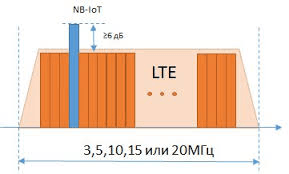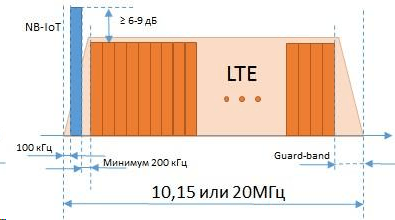1. Stand-alone.

2. In-band.
With this approach, the frequency range inside LTE (GSM signal) is allocated for transmitting NB-IoT packets, but the NB-IoT signal is transmitted at a higher power (6 dB) compared to the LTE signal. This reduces the cost of the frequency spectrum, but at the same time, the increased level of the NB-IoT signal affects the other channels of the network, which may be unacceptable.

3. Guard-Band.
This method involves the transmission of NB-IoT signal in the guard frequency range. For example, in the LTE band of 10 MHz, 500 kHz of the free frequency spectrum is used as a guard interval. In addition, NB-IoT signal is also transmitted at increased power (by 6-9 dB) in comparison with the LTE signal, in order to provide greater coverage. This method allows both to save the frequency range and reduce the influence of the NB-IoT signal on the LTE network. However, the parameters of the LTE signal transmission are deteriorating.
